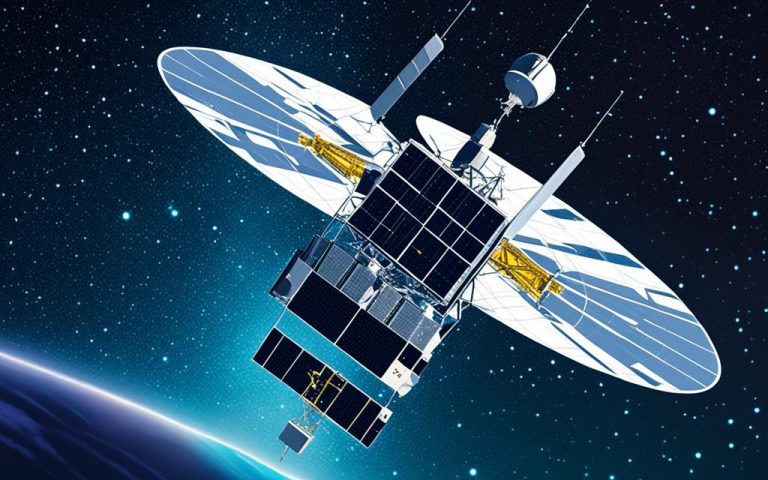Satellite networks play a crucial role in ensuring global connectivity, especially in remote areas and in situations where traditional communication methods are limited. However, these networks have historically struggled with latency issues, which can impact efficient data transmission and overall connectivity. In this article, we will discuss the challenges associated with satellite network latency and explore solutions to minimize latency, ultimately improving global connectivity.
Understanding Satellite Latency
Satellite latency refers to the delay in network traffic caused by the distance between the satellite and the user. Traditional geosynchronous (GEO) satellites, positioned approximately 22,236 miles above sea level, result in ping times of 700ms or more. This latency is primarily due to the round trip time it takes for the signal to travel from the user to the satellite and back.
In contrast, lower orbit satellites, such as low earth orbit (LEO) and medium earth orbit (MEO), offer lower latency options. However, these satellites come with their own challenges as they are constantly moving relative to the Earth’s surface. Additionally, routing data around the Earth requires multiple hops, further increasing latency.
To understand the impact of satellite latency, it helps to visualize the distances involved. The table below provides a comparison of ping times for different satellite types:
| Satellite Type | Approximate Altitude | Ping Time |
|---|---|---|
| Geosynchronous (GEO) | 22,236 miles | 700ms or more |
| Low Earth Orbit (LEO) | 100-1,200 miles | 20-50ms |
| Medium Earth Orbit (MEO) | 8,000-24,000 miles | 100-300ms |
As the table illustrates, lower orbit satellites offer significantly reduced ping times compared to geosynchronous satellites. However, not all applications can take full advantage of these lower latencies due to queuing and other network-related factors.
Geosynchronous Satellites
Geosynchronous satellites are commonly used for various communication purposes, including television broadcasting, internet connectivity, and phone services. However, their high altitude and resulting increased latency make them less suitable for latency-sensitive applications requiring real-time interactions.
Lower Orbit Satellites
Lower orbit satellites, on the other hand, offer reduced latency due to their closer proximity to the Earth’s surface. Their lower altitude allows for faster signal transmission, enabling lower ping times and improved responsiveness in applications that rely on real-time interactions.
Despite the lower latency offered by lower orbit satellites, challenges such as handovers between satellites, ground station infrastructure, and managing a network of moving satellites pose additional complexities. These challenges need to be addressed for lower orbit satellite networks to reach their full potential.
Impact of Latency on Applications
High satellite latency significantly impacts the performance of applications. When using a geosynchronous satellite, chatty applications that require frequent communication between the user and the server experience delays in receiving responses. With ping times of 700ms or more, satellite networks are much slower compared to local area networks (LANs) with response times of 1-3ms and wide area networks (WANs) with response times of 10-300ms.
This latency can make applications intolerably slow or even result in timeouts, especially for real-time applications such as voice over IP (VoIP), video streaming, and online gaming.
“Satellite networks introduce significant latency to the data transmission process, which can have a profound impact on the user experience of applications that require real-time interaction. The delay in receiving responses hinders smooth communication and can make these applications frustratingly slow.”
| Network Type | Response Time |
|---|---|
| Local Area Networks (LANs) | 1-3ms |
| Wide Area Networks (WANs) | 10-300ms |
| Satellite Networks | 700ms or more |
Figure 1: Comparison of Response Times Between Different Network Types
As shown in Figure 1, the difference in response times between LANs, WANs, and satellite networks is significant, with satellite networks having the highest latency. This delay can be particularly problematic for real-time applications that rely on immediate feedback and continuous communication.
Real-time applications such as VoIP, video streaming, and online gaming require a seamless and uninterrupted flow of data. The high latency of satellite networks can cause noticeable lags, choppy audio or video quality, and input delays. These issues can significantly diminish the user experience and make activities such as video conferences, online multiplayer gaming, or streaming high-definition content frustratingly slow.
The Challenges of High Satellite Latency
The long round trip time it takes for data to travel from the user to the geosynchronous satellite and back is the primary cause of high latency in satellite networks. This delay is further exacerbated by the additional hops required to route data around the Earth, resulting in slower response times.
The impact of high latency on chatty applications is particularly pronounced. These applications often engage in frequent back-and-forth communication between the user and the server, and each interaction is subject to the delay caused by the satellite network. The cumulative effect of these delays can significantly slow down the application’s response time, leading to a less efficient and frustrating user experience.
Improving the performance of real-time applications in satellite networks requires innovative solutions and optimization techniques that address the challenges associated with high latency. By adopting strategies such as changing network timeout values, optimizing network requests, and caching data locally, it is possible to mitigate the impact of latency and enhance the overall performance of these applications.
Solutions to Minimize Satellite Latency
While it may not be possible to change the satellite’s position, there are strategies to minimize latency and improve application performance in satellite networks.
One approach is to modify the software’s communication behavior by adjusting network timeout values to account for higher latencies. By increasing the timeout values, the network allows more time for responses, reducing the impact of latency on the overall user experience.
Another solution is to employ overlapping network requests and responses. This technique enables the network to handle multiple data packets simultaneously, maximizing its utilization and minimizing the time spent on waiting for individual packets to complete their round trips.
Caching data locally is another effective way to minimize latency. By storing frequently accessed data locally, applications can retrieve information without relying on the network, thereby reducing the transmission time and latency associated with fetching remote data.
In some cases, WAN optimization solutions prove valuable in overcoming latency challenges. These solutions, which can be implemented through hardware or software, cache data or acknowledge receipt of data locally. This optimization helps to mitigate the effects of latency by minimizing the need for round trips to fetch data from the network.
Additionally, satellite network emulators offer a valuable platform for testing applications in simulated satellite network environments. These emulators allow developers to identify and address latency-related issues before deploying their applications in real satellite networks. By replicating the satellite network conditions, emulator testing helps optimize performance and improve the user experience.

Satellite network emulators provide a realistic testing environment for applications in satellite networks.
Future of Satellite Networks
As we strive to overcome the limitations of geosynchronous satellites, the satellite industry is exploring innovative solutions to enhance the performance and efficiency of satellite networks. One promising development is the utilization of lower orbit satellite constellations, such as Low Earth Orbit (LEO) and Medium Earth Orbit (MEO), which offer lower latency options compared to geosynchronous satellites.
“Lower orbit satellite constellations provide a more agile and responsive network infrastructure, reducing the time it takes for signals to travel.”
However, the implementation of lower orbit satellite constellations comes with its own set of challenges, including cost and technical implications. To address these challenges and optimize performance for different classes of applications, including real-time communications, current and future internet protocols, mobile applications, and extremely delay-sensitive applications, hybrid architectural solutions and protocol modifications are being proposed.
These hybrid architectural solutions aim to strike a balance between performance improvements and the advantages and drawbacks associated with new architectures. By integrating the strengths of different technologies, these solutions offer the potential to significantly reduce latency and enhance the overall efficiency and reliability of satellite networks.
Benefits of Lower Orbit Satellite Constellations:
The utilization of lower orbit satellite constellations brings several key advantages:
- Reduced Latency: Lower orbit satellites are closer to the Earth’s surface, resulting in shorter signal travel distances and lower latency.
- Improved Global Connectivity: With lower latency options, satellite networks can provide more efficient and reliable global connectivity, bridging the digital divide.
- Enhanced Responsiveness: Lower orbit satellite constellations offer a more agile and responsive network infrastructure, reducing the time it takes for signals to travel.
- Increased Network Capacity: By leveraging a constellation of satellites, lower orbit satellite networks can support higher data transmission rates and accommodate more concurrent users.
Comparison of Latency in Different Satellite Network Architectures
| Satellite Network Architecture | Latency Range |
|---|---|
| Geosynchronous Satellites | 700ms or more |
| Low Earth Orbit (LEO) Satellites | 20-50ms |
| Medium Earth Orbit (MEO) Satellites | 50-150ms |
By leveraging lower orbit satellite constellations and implementing hybrid architectural solutions, the future of satellite networks holds incredible potential for reducing latency, optimizing performance, and advancing global connectivity. These advancements will not only benefit various industries relying on satellite communications but also pave the way for new opportunities and innovations in the digital era.
Current Satellite Internet Providers and Challenges
When it comes to satellite internet services, two major providers stand out: ViaSat and HughesNet. These companies offer a range of plans with varying download and upload speeds, catering to different user needs and preferences. However, despite the convenience of satellite internet, there are several challenges that users may encounter, including bandwidth limitations, latency issues, performance concerns, and cost factors.
Bandwidth Limitations: Satellite internet providers typically impose data caps on their plans. These caps restrict the amount of data that users can consume within a specific time frame. Once the data limit is reached, the provider may reduce the bandwidth, resulting in slower internet speeds during peak times.
Latency: One of the main challenges with satellite internet is high latency. Due to the vast distance that signals need to travel between the satellite and the user’s device, there is a noticeable delay in response times. This can impact real-time applications such as video streaming, online gaming, and voice over IP (VoIP).
Performance Issues: Satellite internet connectivity can be affected by atmospheric conditions such as heavy rain, strong winds, or thick cloud cover. These environmental factors can cause signal interference and result in poor connection quality and slower speeds.
Cost Factors: While satellite internet offers connectivity options in remote or rural areas where other forms of internet may not be available, it can be relatively expensive compared to other types of internet services like DSL, fiber, or cable. The cost of satellite internet plans and equipment may deter some consumers from choosing this option.
Despite these challenges, satellite internet providers like ViaSat and HughesNet continue to improve their services, invest in technology upgrades, and explore innovative solutions to address these limitations. However, it is important for users to carefully consider their specific needs, location, and usage requirements before opting for satellite internet as their primary connection.
| Provider | Bandwidth Limitations | Latency | Performance Issues | Cost |
|---|---|---|---|---|
| ViaSat | Data caps may affect bandwidth | High latency due to distance | Performance can be impacted by weather conditions | Relatively expensive compared to other options |
| HughesNet | Usage limits may affect bandwidth | Increased latency due to signal travel time | Connectivity may be affected by adverse weather | Pricing may be higher compared to alternative services |
Conclusion
The traditional challenges of satellite network latency are gradually being overcome through advancements in technology and innovative solutions. Lower orbit satellite constellations, protocol modifications, and hybrid architectural solutions hold great promise in reducing latency and improving global connectivity.
By understanding the impact of latency on applications, we can implement strategies that optimize data transmission in satellite networks. Adjusting network timeout values, utilizing overlapping requests, and implementing data caching are effective ways to minimize the effects of latency. These approaches enable more efficient communication and enhance the performance of chatty applications, real-time applications, and other latency-sensitive services.
These developments not only bring us closer to achieving improved global connectivity but also offer a more reliable and efficient satellite network experience for various applications. As the satellite industry continues to innovate and implement these solutions, we can look forward to a future where satellite networks provide seamless connectivity and bridge the gap between distant locations, ensuring that everyone can benefit from efficient and reliable internet access.
FAQ
What is satellite latency?
Satellite latency refers to the delay in network traffic caused by the distance between the satellite and the user. It is primarily due to the round trip time it takes for the signal to travel from the user to the satellite and back.
Why do traditional geosynchronous satellites have high ping times?
Traditional geosynchronous satellites are positioned approximately 22,236 miles above sea level, resulting in ping times of 700ms or more. This is because of the large distance the signal needs to travel between the user and the satellite.
How does satellite latency impact application performance?
High satellite latency significantly impacts the performance of applications. It causes delays in receiving responses, making applications slower compared to local area networks (LANs) and wide area networks (WANs). This can result in intolerably slow or even timeout issues, especially for real-time applications like voice over IP (VoIP), video streaming, and online gaming.
What are some solutions to minimize satellite latency?
There are several strategies to minimize satellite latency and improve application performance. These include modifying software’s communication behavior by adjusting network timeout values, using overlapping network requests and responses, caching data locally, and utilizing WAN optimization solutions. Satellite network emulators can also help identify and address latency-related issues.
What are lower orbit satellite constellations and how do they reduce latency?
Lower orbit satellite constellations, such as low earth orbit (LEO) and medium earth orbit (MEO), offer lower latency compared to geosynchronous satellites. By positioning satellites closer to the Earth’s surface, they reduce the distance the signal needs to travel, resulting in lower ping times.
What are the challenges faced by satellite internet providers?
Satellite internet providers, like ViaSat and HughesNet, face challenges such as high latency, limited bandwidth, performance issues due to atmospheric conditions, and high costs. These limitations make satellite internet a less preferred option for most consumers compared to DSL, fiber, or cable internet.



















